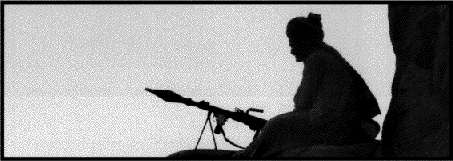A F G H A N I S T A N

1 9 7 3 - 1 9 9 0
Afghan guerilla sentry Gul Mohamar on duty outside a rebel ammunition
dump keeps his RPG-7 anti-tank grenade launcher ready (Reuters/Bettmann Newsphotos).
Afghanistan, an underdeveloped, tribal-based country, deemed strategically insignificant by the U.S. for
decades, became a battleground for the bloodiest and costliest superpower proxy war of the 1980s.
Afghanistan, 1973-1990 contains a comprehensive, day-by-day record of the making of U.S. policy toward Afghanistan.
Approximately 2,500 documents
representing over 15,000 pages of primary source materials--most rarely seen--are published here for the first time.
The overthrow of Afghan King Zahir Shah by his cousin, Mohammad Daud; events leading to the "Saur Revolution" in 1978;
Soviet military intervention in 1979; the entire span of the Soviet occupation of Afghanistan; U.S. covert and overt efforts to
support the Afghan
rebels; internal and external negotiations to end the conflict are all here in microfiched copies of the actual documents originating
from the highest levels of the U.S. government.
What stimulated the U.S. to develop a sophisticated insurgency support operation for a rebellion led by Islamic religious leaders and
fought by mountain tribesmen? What was the nature of the debate among U.S. officials and members of Congress
over U.S. policy? What did the U.S. believe the rebels, fraught with ethnic and tribal rivalries, could accomplish against the armed forces of the Soviet Union? What effect did this
war have on Pakistan--the most important U.S. ally in South Asia? And what lessons has the U.S.
intelligence community drawn from this conflict and applied to America's emerging strategic doctrine of Low Intensity Warfare?
Why did the Soviet Union spend 10 years, billions of dollars, and nearly 20,000 lives trying to prop up a regime that seemed
constantly on the verge of collapse? Why did Gorbachev eventually call the Red Army home and leave the Afghan
government to fend for itself against formidable odds? And how did the Kabul regime manage to hold on to power without Soviet
protection?
No student, scholar, librarian or journalist trying to answer questions related to the Afghan war can do justice to their studies
without reviewing State Department cables from Kabul, Peshawar, Islamabad and Washington; intelligence reports from the CIA
and DIA; correspondence between Congress and the Executive Branch; field reports from AID officials in Pakistan, and the many
other previously classified materials found in this document set.
The Archive prepares extensive, printed finding aids for its collections. The Guide contains an extensive events chronology,
glossaries of key individuals, organizations and military terms and technologies, a bibliography of relevant secondary sources
(including foreign and rebel publications) and a document catalog. The catalog, organized chronologically, provides bibliographic
information for each document and lists all of the indexing phrases generated for each. This facilitates browsing through the
document descriptions and allows researchers to preview key details about documents before perusing the microfiche.The
Index contains subject and name indexes allowing researchers to pinpoint relevant documents in particular areas of study.
Documents in this Collection Include:
- Title:
- Content:
- Arrangement and Access:
- Standards:
- Indexing:
- Date of Publication:
March 1991
- Orders and Inquiries
Return to National Security Archive Microfiche Sets.

